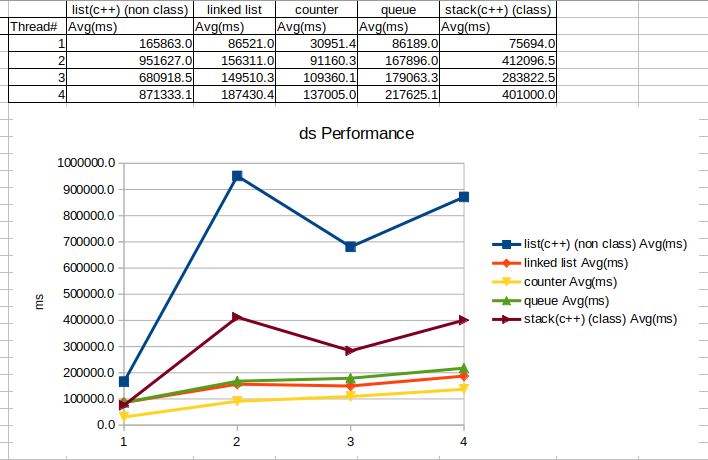A performance comparison among data structures in concurrent programming
About 20 years ago, non-concurrent application can benefit from single core CPU revolution. Every generation of the CPU increases its frequency, application does not require any update, but get running faster than ever. The situation has changed when multi-core CPUs come to life. In order to utilize multi-core CPUs, applications needed to be designed to use threads nowadays. Concurrent programming becomes the key to reveal the potential of multi-core CPUs.
This document is about a performance comparison among a number of data structures in concurrent programming.
Tests environment: 1 – 4 threads on Ubuntu20
Tested data structures:
- integer counter (simple C integer variable counter) [1]
- Queue ( C structure – user defined queue data type) [2]
- Stack (C++ class object std::stack
) [3] - list (C++ non class – std::list is used) [3]
- linked list (C pointer structure – user defined queue data type)[1]
Test subject:
Use a loop of 1 million times to add a number in all kinds of the data structures in a concurrent fashion and meanwhile, to count the time taken.
To integer number, we have a integer variable, count from 0 to 1 million. The threads we tested are from 1 to 4.
Results:

Conclusion:
Based on the result, we came to following understanding:
-
Simple data type or structure costs less time than complex data structure.
-
Programs written in C costs less time than programs written in C++.
-
When threads number increased, the scale issue does happen on each data type or structures.
-
In term of C++ programs:
A. non-class programming has more costs of time than class used programming.
B. When threads increased from 1 to 2, the time taken seems to have a spike. It is strange to see that when threads increased to 3, the time taken decreased significantly comparing with 2 threads used. When threads increased to 4, the average time taken is less than 2 threads used on average.References:
[1] R. Arpaci-Dusseau and A. Arpaci-Dusseau, “Lock-Based Concurrent Data Structures,” in Operating Systems: Three Easy Pieces, Chapter 29, p. 9: https://pages.cs.wisc.edu/~remzi/OSTEP/threads-locks-usage.pdf.
[2] W. Herlihy and N. Shavit, The Art of Multiprocessor Programming Second edition(Morgan Kaufmann, 2021).
[3] A NTHONY W ILLIAMS, C++ Concurrency in Action Second Edition




 浙公网安备 33010602011771号
浙公网安备 33010602011771号